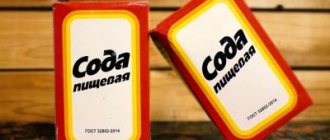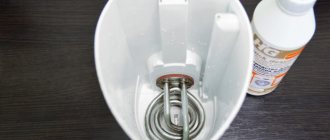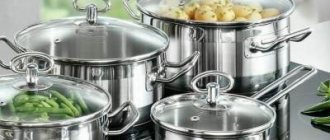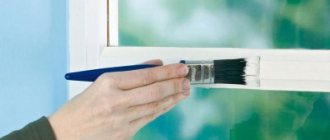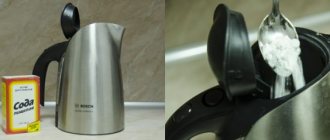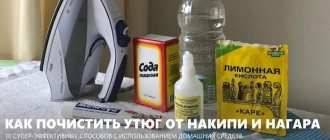/Order/
In any water heating device from time to time we discover a treasure trove of minerals, namely deposits of magnesium and calcium salts from hard water. And if we always try to prevent the occurrence of scale in the dishwasher and washing machine, then what can we say about the kettle, where it not only impairs its performance and leads to breakdowns, but also harms the health of household members.
In this material, we have collected 6 of the most effective and affordable methods at home that will help you descale your kettle. In fact, the secret of all folk remedies is very simple:
- Scale in a kettle or electric kettle is afraid of organic and inorganic acids, so almost all methods of removing it at home are based on the use of acid-containing products.
See also the material: How to clean the iron inside and outside - 10 home methods.
Method 1. How to descale an electric kettle using vinegar
Manufacturers of electric kettles do not recommend using vinegar to remove mineral deposits - after all, it is too aggressive. But sometimes you can’t do without this powerful remedy.
The method is suitable for: plastic, glass and metal teapots with a very large amount of old scale.
Ingredients: water - approximately 500 ml and vinegar 9% - a little less than 1 glass or vinegar essence 70% - 1-2 tablespoons.
Recipe: pour water into a kettle and boil it, then pour acetic acid into the boiling water and leave the scale to soak in the solution for 1 hour, during which you should periodically lift the lid and check how the process of scale is peeling off from the walls of the kettle. If the scale does not come off on its own, but only loosens, then it will need to be removed with a sponge. Be sure to boil water in a clean kettle once or twice and then rinse it thoroughly to remove any remaining vinegar.
Advantages and disadvantages of the method
The method of removing scale using available drugs such as soda and vinegar has many advantages, but there are also some disadvantages.
Advantages of use:
- harmless to health;
- affordable cost;
- availability;
- completely natural product, without chemical impurities;
- good effectiveness in untreated cases;
- ease of use.
Disadvantages of this method:
- there may be poor effectiveness the first time with a thick layer of scale;
- It takes time for the solution to work - the result is not immediate.
Despite some disadvantages, the use of soda and vinegar is a very effective method of removing scale.
Method 2. How to descale an electric kettle using citric acid
The method is suitable for: cleaning electric kettles made of plastic, stainless steel and glass with light or moderate dirt.
Ingredients: water - approximately 500 ml and citric acid - 1-2 tablespoons (depending on the degree of contamination). A quarter of a lemon can replace powdered acid.
Recipe: we also pour water into a kettle and boil it, then pour citric acid into the boiling water or put a quarter of a lemon and wait until the water cools down for about 1-2 hours (the acid that gets into the hot water will “hiss”). If the scale is not old, it will come off on its own. Otherwise, you will have to put in a little effort. Remember to boil water in a clean kettle and then rinse it thoroughly.
Why clean the kettle?
This question does not arise when you see a thick coating on the bottom and walls of the device. Unpleasant and unedible particles fall off over time and end up in drinks.
A few more reasons why you need to remove plaque:
- Lime slows down the boiling of water because it has low thermal conductivity. Electricity consumption increases.
- The heating element in an electric kettle may fail.
- The taste of the water changes for the worse and it becomes cloudy.
Even after a series of purifications, a small percentage of impurities still remains in the water. This doesn't mean you don't need to use filters. You just need to be prepared for the fact that even the highest quality water will accumulate plaque on the walls of the device, regardless of the material of the device. The difference is that with clean water, equipment will have to be cleaned much less often.
The problem is solved in a few minutes, and the cleaning costs will not hit the budget at all.
Three simple substances that quickly and effectively corrode plaque:
- vinegar;
- baking soda;
- lemon acid.
If the kettle has not been cleaned for a long time, the methods can be combined, or one can be used several times. Sooner or later you will be able to get rid of even a thick layer of plaque. What you should not do is try to wash off the sediment with abrasive agents. This will damage the walls of the kettle, and the device will completely deteriorate.
We recommend: How to properly soak peas for soup, porridge and puree?
Method 3. How to get rid of scale in a kettle of any kind using soda
Enameled and aluminum dishes are afraid of aggressive acids, so the first 2 methods of removing limescale are not suitable for them, but a regular soda solution can help you.
The method is suitable for: descaling both in conventional enamel and aluminum kettles, and in any electric kettles.
Ingredients: baking soda, or preferably soda ash – 1 tablespoon, water – approximately 500 ml (the main thing is that it covers all the limescale).
Recipe 1: to remove scale from the walls of an enamel or aluminum kettle, you must first mix soda with water, then bring this solution to a boil, and then leave it to simmer over low heat for half an hour. At the end of the procedure, wash off the remaining soda by boiling clean water once, draining it and rinsing the kettle.
Recipe 2: to clean an electric kettle with soda, you need to boil water, make a soda solution, and then let it cool for 1-2 hours. A more gentle way is to pour soda into boiling water, and then leave the solution until it cools completely - during this time, the mineral deposits will become softer, and it will be easier to wash them off by hand.
Can these cleaning products be used at home?
The sediment that appears as a result of boiling water is difficult to remove by simply washing the kettle. This is due to the fact that lime deposits are insoluble in water.
Even purchased purified water, like water that has passed through home filters, has a low level of mineralization and can also form sediment during the heating process.
Vinegar is an acid that reacts with sediment substances and destroys them. Soda is an alkali that helps loosen scale. With the simultaneous use of acid and alkali, the effect is enhanced and the plaque is destroyed.
Table vinegar and baking soda are food products that can be used to treat the inside surface of a kettle.
Method 4. How to descale a kettle using Coca-Cola and Sprite
This method is not the most effective and economical, but why not try it for fun?
The method is suitable for: descaling in ordinary stainless steel kettles and electric kettles, but for enameled and tin kettles - with caution.
Ingredients: any carbonated drinks with citric acid in the composition are suitable - from Coca-Cola to Fanta. But it is better to take colorless drinks, for example, Sprite or Schweppes.
Recipe: First, release the gases from the drink, then pour 500 ml of liquid into the kettle and let it boil, and then cool. The result of the experiment can be seen in this video.
See also the material: How to clean an automatic washing machine from dirt and scale in 5 steps.
The role of the substance in descaling
The effectiveness of using vinegar in removing known plaque is explained by a common chemical reaction: when acid reacts with scale, the components decompose into water, gas and easily soluble calcium acetate. An important catalyst that is responsible for accelerating decomposition processes is thermal exposure or prolonged soaking.
Heating or soaking leads to the destruction of the scale - it becomes loose. Some of the connections come away from the surface on their own; some will have to be removed using a soft sponge. If the coating was thick and the manipulations had no effect, boil the kettle with vinegar again.
Vinegar is not the only acid that effectively fights plaque. Other acids used in the kitchen are also suitable: for example, citric acid. But, if lemon or citric acid is not always available, then vinegar in different concentrations constantly lives in the kitchen.
Method 5. How to remove scale from a kettle using apple or potato peelings
This product is suitable either for preventative care or if the limescale deposits are still weak.
The method is suitable for: descaling ordinary enamel and metal kettles.
Ingredients: apple, pear or potato peelings.
Recipe: place apple, pear or washed potato peelings in a kettle, fill with water and bring to a boil. As soon as the water boils, leave the peel to cool for 1-2 hours, and then wash off the softened plaque with a sponge.
How often should deposits be removed?
Regular cleaning will help prevent excessive limescale build-up.
The surfaces of a glass teapot need to be cleaned at least once every seven days (tiny particles of limescale are visible on the transparent walls). Monthly cleaning will help keep metal or ceramic teapots clean.
The frequency of cleaning is affected by the quality of the water used . By pouring bottled or well-filtered water into dishes, you can reduce the number of cleanings to a minimum.
Method 6. How to descale a kettle using brine
Since brine contains organic acids, it can also be used to remove scale and rust. Therefore, if you have cucumber or tomato brine on hand, which, as often happens, has nowhere to put it, feel free to put it to use.
The method is suitable for: descaling ordinary enamel and metal kettles.
Recipe: pour the brine into a kettle through a sieve (so that nothing extra remains in it), bring it to a boil, then leave the brine to cool for a couple of hours. Using a sponge, we remove any remaining limescale and rust and, finally, rinse the kettle clean with running water.
Benefits of baking soda
Baking soda is a slightly alkaline white powder, widely used in baking and cooking. It is a universal remedy for everyday use: it can easily remove grease from the oven, clean the bathtub and sink, and whiten laundry. But the main advantage of soda is its safety. Its decomposition occurs at a temperature of 60 degrees, and when boiled it does not emit caustic fumes.
Sodium bicarbonate helps loosen limescale, remove odors and has disinfectant properties. If there is an unpleasant smell in the refrigerator, place a saucer of baking soda on the shelf.
Some useful tips for prevention
To keep your kettle running and always drink unadulterated drinks, follow these 3 simple rules:
- Try to descale the kettle regularly - once a month or every two months. For preventative cleaning, delicate products such as fruit peelings or brine are suitable.
- Try to boil only filtered water. This is good for both your health and the teapot.
- Try to pour out any remaining water that remains on the bottom of the kettle and rinse it before adding fresh water to boil.
General recommendations
Regardless of which kettle you have in front of you - electric or metal for the stove - the tips for caring for it will be identical:
- Clean the device at least once a week so that you don’t have to scrape off too thick a layer of limescale;
- drain the remaining water from the kettle overnight, and pour a new portion in the morning;
- use only cleaning products labeled “for kitchen and food equipment”;
- clean the outer surface with soft, non-aggressive abrasives;
- Before performing hygiene measures, unplug the device (remove it from the stove) and let it cool.
How to clean the outside of a kettle from carbon deposits and grease
Often aluminum and enamel kettles become coated with soot and grease on the outside. If the first aid of washing up liquid and a sponge does not work, try the following 3 methods (for regular enamel, aluminum and stainless steel kettles).
Method 1.
Step 1. Heat the kettle until it is warm enough, but not scalding.
Step 2. Prepare a liquid paste from baking soda and water in proportions of 3:1.
Step 3. Using a sponge, treat all contaminated surfaces with the resulting solution, leave for 5 minutes (optional), and then clean off carbon deposits and grease, making circular movements with the hard side of the sponge.
Step 4: Finally, wipe the kettle clean.
Method 2.
You can clean the outside of the kettle from old carbon deposits and grease by boiling it in a soda solution.
Step 1. Fill a large saucepan/basin/metal bucket with water.
Step 2. Dissolve soda in water at the rate of 1 tablespoon per 1 liter of water.
Step 3: Place your stainless steel cookware in the water and turn on the heat.
Step 4. When the water boils, boil the kettle for another 30 minutes, and then remove the container from the heat and leave to cool.
Step 5. Using the hard side of the sponge, clean off any remaining carbon and grease and finally rinse under running water.
Method 3. Only for stainless steel or aluminum kettles
Aluminum and stainless steel kettles can be cleaned from the outside of carbon deposits, rust and grease by boiling them in a vinegar solution. Just follow the previous instructions, but instead of soda, use 9% table vinegar at the rate of 3 tbsp. spoons per 1 liter of water.
Procedure
To remove a thick layer of scale at home, you can use table vinegar and baking soda.
The procedure is not complicated:
- Pour ½ cup of vinegar into an empty container.
- Pour 1 tbsp. l. soda
- After the reaction is complete, add water to the full volume.
- Place on the stove.
- Boil for 30 minutes.
- Let stand until cool.
- Pour out the water.
- Rinse.
For particularly persistent deposits that have a layered structure and cannot be removed immediately, another method can be used. It is suitable for electric and regular kettles.
Stages of work:
pour water into the kettle, not reaching the top by about the volume of a glass;- bring water to a boil;
- add 3 tbsp. l. soda;
- remove from heat;
- let stand for 30 minutes;
- boil again;
- drain the water;
- wash the dishes;
- draw water;
- add ½ cup vinegar or 1 tbsp. l. vinegar essence;
- boil for 30 minutes;
- Wash the kettle using steel wool.
If there is only a small amount of plaque, then even a recipe based only on soda (without adding vinegar) will help. To implement it you will need:
- Pour water more than half the volume of the kettle.
- Pour 3 tbsp. l. soda
- Boil.
- Keep on fire for 30 minutes.
- Remove from heat.
- Leave for 60 minutes.
- Wash off the sediment using a brush.
With a thick layer of scale, a combination of soda and vinegar will help. In most cases, you will need to make several rounds of cleaning.
Why you should use baking soda
Baking soda has these qualities:
- non-toxic;
- when reacting with water, carbon dioxide is released, which simplifies cleaning;
- has antiseptic properties.
Soda is used to clean porcelain, metal, earthenware, plastic and other surfaces . With the help of this substance, housewives clean dishes much faster than with other products.
